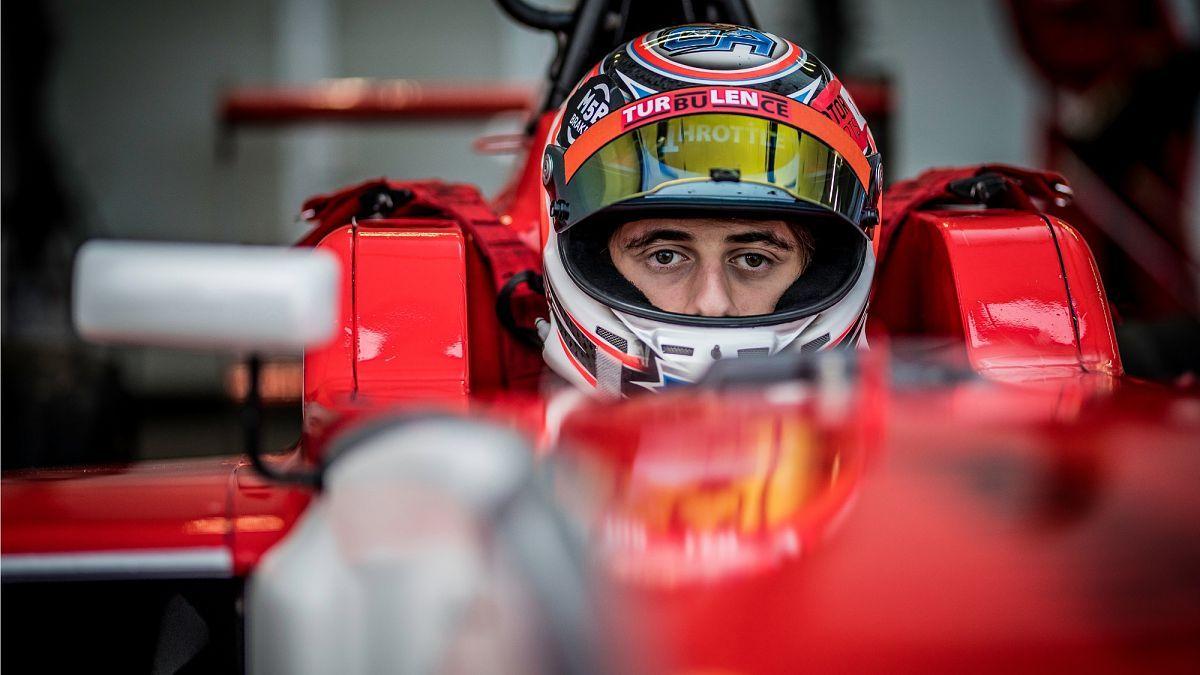AI Revolutionizes Sports Viewing: From Formula One to Football
2 Sources
2 Sources
[1]
Ball speed and fuel burn: How AI is bringing sport closer to fans
"The future of entertainment is multi-dimensional, it's highly personalised and it's extremely interactive," Samira Panah Bakhtiar, General Manager of Media & Entertainment, Games, and Sports at Amazon Web Services, told Euronews. Most of us have a sport that we just love to watch, whether it's something more mainstream, such as football and Formula One (F1), or something slightly harder to access regularly, such as equestrianism, strongman or swimming. And while many super fans have been taking part in fantasy leagues or replaying their favourite goals online for years, generative artificial intelligence (Gen AI) is set to democratise the way we can all access, engage with, and enjoy our favourite sports. Euronews Next spoke to Samira Panah Bakhtiar, General Manager of Media & Entertainment, Games, and Sports at Amazon Web Services (AWS), to find out how they're helping fans get closer to the action. If you've ever watched F1, you probably enjoy the nail-biting speed, driver tactics, and listening in to the team radio - which can often provide comical moments. Now, by ingesting over a million points of data during every minute of every race throughout a season, across the world, AWS has helped F1 up the viewer experience. "As viewers are watching it, [AI] can help to predict the overtake rate of a driver against another driver," Samira explained. "Just recently, we announced a burn metre where they're able to now assess how much gasoline is being burned based off the velocity of a driver in any given moment across a turn, or in the case of an overtake. And then they have that burn metre of their gas stack ranked, and that obviously makes a difference in the race". In the same way, Germany's Bundesliga is using AI to calculate the probability of a goal or the speed and velocity of a kick. Fans can access the stats on their app and the Bundesliga has reported an increase in app engagement by 68 per cent. AWS have also worked closely with the European Football League (ELF) to help them streamline their coverage production. Whilst that might just sound like industry lingo, the knock-on effect for football fans is huge, and could be replicated across all sports. By using the cloud for live sport coverage production, the ELF have reduced the need to transport editors, graphic artists and other crew onsite for events. While this might be less fun for the crew, it massively reduces transport emissions and saves costs. Across an entire season of games, it was estimated to have saved over 300 tonnes of CO2 emissions. That's the equivalent of the amount of energy just 40 average homes would use in a year. "And by democratising the cost of it, you're able to cover more sports," Panah Bakhtiar told Euronews Next. "So we've seen a lot of our customers who could traditionally only afford to cover, let's just call it, tier one events for a full calendar year, now be able to cut the cost down, and then be able to send more people to tier two or tier three sporting events to provide more options". With this in mind, it could mean more money available to increase content around less popular sports. "I grew up riding horses, I love watching equestrians. There's not a lot of equestrian content out there, but being able to now know that I can find the content that I care about watching when I want to watch it, and the cost for production is coming down, it allows for more choice. I think that's a really beautiful thing," Panah Bakhtiar said. She is particularly excited about what AI means for the future of entertainment and fan engagement. "Gen Z, 47 per cent of them prefer social media and short-form content over that of traditional linear content or streaming content. Actually, their number two preference after social is gaming. And then after that, it's audio and music. "So I think the interesting part for me has been seeing how these demographics are creating a lot of volatility, but if you pay attention, the opportunity is quite vast. "I think last year alone, the entertainment industry generated over a trillion dollars in revenue, with 35 per cent of that coming from online video and 25 per cent of it coming from games, and it's only growing". Panah Bakhtiar thinks that for companies that are willing to be experimental with new products and embrace the use of cloud computing, artificial intelligence and purpose-built services that focus on game or content development, the whole entertainment landscape could be completely reinvented. "My prediction for the future of entertainment is that it's multi-dimensional, it's highly personalised and it's extremely interactive," she said.
[2]
How AI and cloud technology are reengineering Formula One racing
"F1: The Movie" is an old-fashioned blockbuster that delivers with respect to story, but excels in putting audience in driver's seat. As you watch your favorite F1 drivers tear around the MSC Cruises Austrian GP this weekend -- or maybe catch the much-hyped Hollywood flick starring Brad Pitt -- know that technology is helping to drive the performance of Formula One racing. To help collect, analyze and deliver valuable insights to racing teams, every F1 car houses about 300 sensors, which generate an incredible 1.1 million telemetry data points per second, transmitted from the cars to the pits, in real-time. For the past seven years, Amazon Web Services (AWS) has been a key technology partner of the Formula One organization, leveraging its AI and cloud platforms to help process and interpret all this data from F1 vehicles. Not bad for a 75-year-old sport that originally relied solely upon one tool for decades: a stopwatch. "Today, there's copious amounts of data collected, and so artificial intelligence and machine learning are key to make sense of it all," explains Julie Souza, who leads AWS for sports. "Shaving off milliseconds can make a huge difference on the track, such as finding you're over-rotating a particular lug nut, which may cause instability in the engine; and so a team like Scuderia Ferrari (an official AWS team partner since 2021) can glean very useful information to help with race strategy that was previously unmeasurable," adds Souza. "That's just one small example of the incredible amount of data analyzed at high speeds." Interestingly, with Formula One, aerodynamics data analysis has even yielded changes in car design. Called "Computational Fluid Dynamics," simulations ran in the cloud analyze fluid flow around the car, and found that trailing cars required much more force to overtake. And so, this data led to changes in body design in 2022 that saw more than 30 percent more overtakes, much to the delight of F1 fans, no doubt. Yours truly had a small taste of race car data collection and analytics, as I recently drove a Ferrari 296 GTB on a track in Fiorano, Italy, ahead of catching an F1 Grand Prix practice race. An engineer walked me through my telemetry data following several laps. How'd I do? I'll stick to writing articles. Data drives fan engagement, too Sports and racing fans, it seems, are hungry for more information. "Over the past few years, we've seen fans are more connected and engaged to their favorite sports when there is more data and deep insights, which helps them better understand and appreciate what they're watching," says Souza. Technology allows fans to curate their own viewing experience in a way that's highly personal to them," says Souza. "What's interesting to me may not be relevant to you, and so data is unlocking true personalization, for a more engaging experience." For example, Souza says today's sports broadcasts and apps can be highly customized -- and will be even more so in the near future. "You can choose different angles and audio feeds, maybe buy tickets to an upcoming game or a jersey of your favorite player, follow a fantasy team or place a bet, chat with friends, or have Uber Eats deliver you something 20 minutes into a game." This personalization is paying off, according to Souza, highlighting the success of the partnership with Bundesliga that has returned a 68 percent increase in fan engagement on its data-heavy app, and 60 percent longer session times. "I always say if you feel smart about what you're watching, you'll probably watch more of it." AWS has partnerships with other sports leagues, such as the NHL, NFL, PGA Tour and Germany's Bundesliga soccer league. Amazon says soccer matches produce 3.6 million points of data per game. Tech for broadcasters Not only has technology changed how Formula One delivers F1 races to fans -- streaming over various platforms and often with interactive elements, such as selecting specific camera views -- it also helps broadcasters deliver a richer experience for viewers. "Tracks can be six kilometers in length, and so the action is happening in a wide expanse and at the same time, and so data collected and packaged by AWS helps producers tell the story about what's going on," says Adrian De Luca, Director of Cloud Acceleration at AWS, for Asia Pacific and Japan. Car telemetry can also inform broadcast producers on what may happen next, so they can prep videos and graphics for viewers. "Data can be predictive, such as when an overtake might be expected," adds De Luca. "Data is collected as the cars are going by, via beacons placed every 150 to 200 meters or so, that collect telemetry of all 20 cars, which is then sent to F1's headquarters in Biggin Hill." De Luca says more than 500 terabytes of data is collected each race weekend. Tech is helping broadcasters in other ways. NHL and AWS delivered the first cloud-based broadcast in March 2024, delivering high-quality and personalized live games with minimum onsite gear, and cutting CO2 emissions by more than 2 metric tonnes. Tech can also help unlock previously unviewed coverage. While recorded, Souza says only 15 percent of PGA Tour's 30,000-plus shots during a tournament are televised. A customized app can deliver the remaining 85 percent, and with AI-produced commentary in multiple languages. For safety's sake, too Sensors, coupled with AI and machine learning and cloud processing, is also being leveraged for greater safety of players. In the NFL, where about 500 million points of data is collected per week, data helps identify players that are at risk of injury, and helps coaches and owners make impactful changes. This resulted in 700 fewer missed games in this last season, says Souza. "It's a win-win-win, as top players want to be on the field, as do the team owners who spent a lot of money on them, and fans want to see their favorite players." Another case for data analysis in the NFL: Instead of all players wearing the same helmets, sensors identified that players in different positions were hit differently. As a result, today there are eight position helmet shapes to reduce the odds of head injuries, such as concussions. Whether it's crossing the endzone or the finish line, tech is unlocking deeper experiences for athletes, fans and broadcasters alike.
Share
Share
Copy Link
AI and cloud technology are transforming sports entertainment, offering personalized experiences and deeper insights for fans across various sports, from Formula One racing to football and beyond.
AI Transforms Sports Viewing Experience
Artificial Intelligence (AI) and cloud technology are revolutionizing the way fans engage with sports, offering unprecedented levels of personalization and insight. Amazon Web Services (AWS), a key player in this transformation, has been partnering with various sports organizations to enhance viewer experiences and streamline production processes
1
2
.Formula One: Data-Driven Racing

Source: Euronews
In Formula One (F1), AI is taking fan engagement to new heights. Each F1 car is equipped with about 300 sensors, generating an astounding 1.1 million data points per second
2
. This data is transmitted in real-time from the cars to the pits, where AWS's AI and cloud platforms process and interpret the information.Julie Souza, who leads AWS for sports, explains, "Shaving off milliseconds can make a huge difference on the track." For instance, AI can detect issues like over-rotation of a lug nut, which could cause engine instability
2
. This level of analysis helps teams like Scuderia Ferrari optimize their race strategies.Enhancing Fan Engagement Across Sports
The impact of AI extends beyond F1. In Germany's Bundesliga soccer league, AI calculates the probability of goals and the speed of kicks. Fans can access these stats via an app, resulting in a 68% increase in engagement
1
. Similarly, the NHL and NFL are leveraging AI and cloud technology to provide richer, more interactive experiences for viewers2
.Personalized Viewing Experiences
Samira Panah Bakhtiar, General Manager of Media & Entertainment, Games, and Sports at AWS, predicts that "the future of entertainment is multi-dimensional, highly personalised and extremely interactive"
1
. AI allows fans to curate their viewing experience, choosing different camera angles, audio feeds, and accessing real-time statistics.Eco-Friendly Production and Democratization of Sports Coverage
Cloud-based production is not only enhancing viewer experiences but also contributing to sustainability efforts. The European Football League (EFL) has reduced the need for on-site production crews, saving an estimated 300 tonnes of CO2 emissions across a season
1
. This cost-effective approach also allows broadcasters to cover more diverse sporting events, potentially increasing content for less popular sports1
.Related Stories
Safety and Performance Optimization
Beyond entertainment, AI is being used to enhance athlete safety and performance. In the NFL, data analysis has helped identify players at risk of injury, resulting in 700 fewer missed games in the last season
2
. This application of AI demonstrates its potential to not only improve viewer experiences but also contribute to the well-being of athletes.The Future of Sports Entertainment
As technology continues to evolve, the sports entertainment landscape is poised for further transformation. With Gen Z showing a preference for social media and short-form content, the industry is adapting to new consumption patterns
1
. The combination of AI, cloud computing, and purpose-built services for content development is set to reinvent the entire sports entertainment ecosystem, offering fans more immersive and interactive experiences than ever before.References
Summarized by
Navi
Related Stories
Recent Highlights
1
AI Chatbots Sway Voters More Effectively Than Traditional Political Ads, New Studies Reveal
Science and Research

2
Google AI glasses set to launch in 2026 with Gemini and Android XR across multiple partners
Technology

3
EU Launches Antitrust Probe Into Google's AI Training Practices and Content Usage
Policy and Regulation








